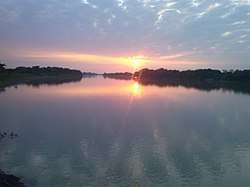Catatumbo River
The Catatumbo River (Spanish: Río Catatumbo) is a river rising in northern Colombia, flowing into Lake Maracaibo in Venezuela. The Catatumbo River is approximately 340 kilometres (210 mi) long. It forms a part of the international boundary between the two countries.
| Catatumbo River | |
|---|---|
 | |
| Location | |
| Countries | |
| Department (CO) | Norte de Santander |
| State (VE) | Zulia |
| Physical characteristics | |
| Source | |
| • elevation | 2,000 m (6,600 ft) |
| Mouth | Maracaibo Basin |
| Length | 500 km (310 mi) |
| Basin size | 22,317 km2 (8,617 sq mi) |
The river flows through the Catatumbo moist forests ecoregion.[1] It then flows through the Maracaibo dry forests ecoregion before emptying into Lake Maracaibo.[2] Together with the nearby Escalante River, Catatumbo is a producing area for cocoa beans of the Criollo cultivar.
Catatumbo lightning
The "Relámpago del Catatumbo" or "Faros del Catatumbo" (Catatumbo lightning) is a phenomenon that occurs over the marshlands at the Lake Maracaibo mouth of the river, where lightning storms occur for about 10 hours a night, 140 to 160 nights a year, for a total of about 1.2 million lightning discharges per year. The light from this storm activity can be seen up to 40 kilometres (25 mi) away and has been used for ship navigation; it is also known as the "Maracaibo Beacon" for this reason.[3]
References
- Locklin, Claudia, Northern South America: Northern Venezuela (NT0108), World Wildlife Fund, retrieved 2017-04-23
- Locklin, Claudia, South America: Northwestern corner of Venezuela (NT0222), WWF: World Wildlife Fund, retrieved 2017-04-24
- "Fire in the Sky". Archived from the original on 2008-05-23. Retrieved 2017-07-09.
The flashes are visible up to 40 kilometres away and have been used as a natural lighthouse for centuries, which is why this semi-permanent storm is also known as the "Faro de Maracaibo", or "Maracaibo Beacon".